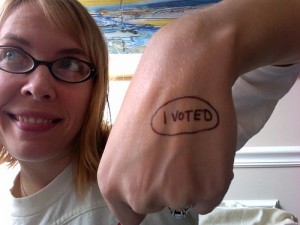 On May 12, 2009, British Columbia voters went to the polls. Voter turnout was dismal, and some say reflects a crisis! The day before, May11, the Obama government announced its Office of Public Engagement. The lack of engaged citizenry creates real learning opportunities. How will British Columbia respond?
On May 12, 2009, British Columbia voters went to the polls. Voter turnout was dismal, and some say reflects a crisis! The day before, May11, the Obama government announced its Office of Public Engagement. The lack of engaged citizenry creates real learning opportunities. How will British Columbia respond?
What does it mean to engage the public?
At the heart of public participation and engagement is seeking out and involving those who are effected (by a decision) throughout the decision-making process, from the very get-go, and in meaningful ways. The International Association for Public Participation (IAAP) has developed core values for the practice of public participation along these lines, and as a guide for travels along the participation path, a spectrum of public participation.
Another view on engagement I like is Peter Block’s principles for community belonging and transformation:
- The leader’s role is to convene (i.e., to produce the engagement).
- Questions are more transforming than answers.
- Being part of the important conversations leads to a feeling of belonging.
- The small group is the unit of transformation.
- People need to be invited, and made welcome when they show up.
- Provide supportive physical and social spaces (e.g., my post 20 ways to physically structure your office for collaboration build’s on Block’s ideas).
Government 2.0
Governments world wide are seeking ways to ensure that they remain relevant, open and transparent to their constituencies. There is momentum out there for governments and leaders to embrace the spirit of collaboration, of creativity and trial-and-error characteristics.
Government 2.0 (Gov 2.0) is a term used to describe application of the social networking and collaborative advantages of Web 2.0 to the practice of government. The stakes are high. Will Gov 2.0 be a golden age for social media and networking? Here’s some examples of Gov 2.0 in practice:
- Connecting the government community to itself is: GovLoop – Social Network for Government 2.0. Innovative, and mushrooming in usage. Membership extends beyond government employees to include contractors and academics working with government.
- Vote for where the Parks Board should allocate your tax money. The government of London, U.K. asked the public to do just that. Read more in Help a London Park.
- Apps for Democracy contest (winners get $) in which the Washington, DC Chief Technology Officer asks the public for innovative applications of technology to address citizen service needs. The result is 47 web, iPhone, Facebook applications. Check out the Apps, and the latest DC Gov 2.0 initiative, in this video presentation.
I’ve gained lots of insight on Gov 2.0, and examples from around the world (including some in this post), from Wikinomics.
What now for my government and political leaders?
Here’s some thoughts that come quickly to mind:
- Think some more about the questions you want to ask the public. Questions open the door to the future and are more powerful than answers in that they demand engagement. Engagement is what creates accountability.
- Create processes, in composition and structure, that exemplify the future you want to create.
- Open up access to government data. It’s needed for citizen-driven technology innovation.
- Empower citizen innovation. Re-think who has the gifts from which many can benefit…now. How many more multi-million $, multi-year, minimal ROI, product development cycles do we need?
- Encourage social enterprise. It’s needed just as much as for-profit business (read some of my thoughts on this here).
- Engage and develop local bloggers. Successful bloggers offer insight into the art of online conversation (I’m partial to this one; the idea, if not the success!).
What message would you pass on to the BC Government and political leaders?
If you enjoyed this post, please consider leaving a comment or subscribing to the feed to have future articles delivered to your feed reader.
Photo credit: sundaykofax

Speak Your Mind